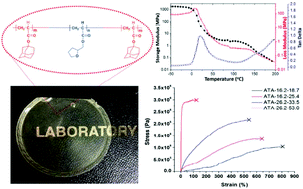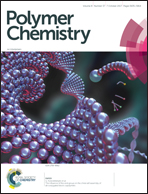All acrylic-based thermoplastic elastomers with high upper service temperature and superior mechanical properties
Abstract
All acrylic-based thermoplastic elastomers (TPEs) offer potential alternatives to the widely-used styrenic TPEs. However, the high entanglement molecular weight (Me) of polyacrylates, as compared to polydienes, leads to “disappointing” mechanical performance as compared to styrenic TPEs. In this study, triblock copolymers composed of alkyl acrylates with different pendant groups and different glass transition temperatures (Tgs), i.e. 1-adamatyl acrylate (AdA) and tetrahydrofurfuryl acrylate (THFA), were synthesized via reversible addition–fragmentation chain transfer (RAFT) polymerization. Thermal characterization of the resulting polymers was performed using differential scanning calorimetry (DSC), and the Tgs of both segments were observed for the block copolymers. This indication of microphase separation behavior was further demonstrated using atomic-force microscopy (AFM) and small angle X-ray scattering (SAXS). Dynamic mechanical analysis (DMA) showed that the softening temperature of the PAdA domains is 123 °C, which is higher than that of both styrenic TPEs and commercial acrylic based TPEs with poly(methyl methacrylate) (PMMA) hard block. The resulting triblock copolymers also exhibited stress–strain behavior superior to that of conventional all acrylic-based TPEs composed of PMMA and poly(n-butyl acrylate) (PBA) made by controlled radical processes, while the tensile strength was lower than for products made by living anionic polymerization.



 Please wait while we load your content...
Please wait while we load your content...